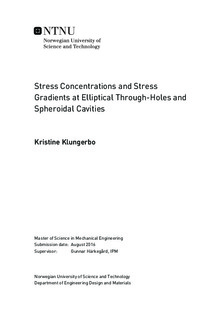| dc.description.abstract | The effect of thickness and Poisson's ratio on the stress concentration factor and the stress gradient at the notch root of central elliptical through-holes in plates are systematically investigated using three-dimensional finite element method. The effect of Poisson's ratio on the stress concentration factor at central spheres and circumferential grooves in cylinders is also presented using two-dimensional finite element method. Few solutions in literature considers the three-dimensional behaviour of structures, even though it greatly affects the properties of the stress concentration factor. This research aims to provide a systematic and critical presentation of the stress concentration factors and stress gradients for plates and cylinders. Ultimately, the goal is to provide methods and data that allows for more reliable fatigue assessments.
The results show that the stress concentration factor is strongly dependent on the shape of the irregularity, the plate thickness and the Poisson's ratio. It is found that Kt,max moves from the mid-plane towards the free surface of the plate with increasing thickness, but never reaches it. For large thicknesses, Kt,max is 21.3% higher than Kt,surf for a circular hole when v = 0.3, and the difference increases to 40% when v = 0.45. The stress gradient at the notch root of a central through-hole is lowest where Kt = Kt,max and highest at the free surface of the plate. The value of the lowest stress gradient lies 1% below the analytical value. With the lowest stress gradient positioned at the point of maximum stress, the volume of highly stressed material is larger than accounted for by conventional methods for fatigue calculations. A fatigue assessment based on the finite element results show that the fatigue life is drastically overestimated by conventional methods. An analytical approach leads to an overestimated fatigue life of 57.7%, compared to a calculation based on the three-dimensional numerical results. This rises concerns about the conventional methods, and highlights the importance of research within this field. | |

